
Amok Island is a multi-disciplinary artist from the Netherlands, based in Fremantle, Western Australia. Heavily inspired by early naturalists’ scientific illustrations, his work embodies the accuracy and precision representative of technical drawings, used for identification purposes. The theme of natural exploration and conservation is a strong and constant undercurrent of Amok Island’s artistic practice. His lifelong fascination with nature and her relationships and history with mankind drive the artist’s obvious appreciation and obsession with his subjects and his urge to direct the attention of his audience to them. Amok Island pursues a point of balance where minimal shape and colour remain capable of realistically representing a subject. To accomplish this, he renders his subjects to near bare minimum geometric elements of form, and places paramount importance on the use of a carefully considered colour palette.
Interview by Gab Lewis. Photos supplied by Amok Island.
We're very excited to have you for a show this year. What do you have in store for us?
Thank you! I have tried to approach this exhibition with no rules, forget about my own ‘rules’ and tried to simply paint what excited me. I have enjoyed experimenting with new ideas, like the night driving works, and found some other interesting approaches, like the multi colour borders on the botanical works are a new thing for me. It resulted in six very varied pieces that somehow also work together I think.
You have previously discussed alternative career options, including the possibility of being a biologist! What brought you down the creative path instead?
I have never been very good at school, and the studies I have tried (including art school) I quit in a few months. I have been lucky to come from a graffiti background and somehow managed to find a way to do this for a living. My way of learning is doing it myself by trial and error, as opposed to being taught.

The combination of the natural environment and geometric, graphic shapes is a notable characteristic of your work. Talk us through how this aesthetic developed!
Photorealism has never really attracted me. I appreciate the skill, but for me the challenge is to put together something using simple shapes and limited colours that is interesting to look at. When I design a work I test this by squinting my eyes while looking at my work and if the geometric shapes morph into a realistic looking image I am on the right track.
In a world of millions of species, what draws you to certain creatures and plants? Do you have a favourite to illustrate?
I don’t have a favourite. I just get inspired by new things randomly and want to see how it goes when I translate them into my style. This is sometimes a colourful charismatic popular species, or sometimes an overlooked species that is considered boring or a weed/pest. I do not often paint the same thing twice because I am motivated by the challenge of trying new things. I don’t particularly care about the action of painting itself. I like to set myself a challenge and see the outcome.

Can you give us some insight to how works come to life behind the scenes? What role does photography, sketching and documentation play in your practice?
Photography is a big factor in my work. I do a lot of nature photography, especially underwater. The photos I take often inspire new works and my paintings sometimes give me ideas on how to take photos too. I never sketch. When I get an idea I often 'see' the artwork in my imagination and go straight to illustrator where I design the artwork using my own reference photos, or images from books or google. I often take different parts of different photos to combine into my own image. For example: the body shape of one image, mixed with the head of another image and the tail of another image. I spend most of my time on illustrator puzzling with composition, colours etc to get that sweet spot balance. Just to fine tune everything before I paint anything. When I start a canvas or mural I just paint what I ended up with on the computer and I generally don’t change anything.
How does your process vary when working in large scale murals vs smaller prints? Do you have a preference of the two?
I definitely like large murals the most. The impact of anything painted XXXXL is just exciting. When I have an exhibition that I have to create work for, it often takes a bit of effort to feel inspired to do smaller works. Often when I have a good idea for a piece I feel it's wasted on a canvas and it should have been a big mural. The good thing about canvas work opposed to public art is that you do not have to please anyone but yourself. It's a good time to experiment and try new things.

The intersection of urban and natural environment is striking in your large scale mural work. Is location and the surrounding region something that is considered when producing these public pieces?
Definitely. It is cool when you can find a subject that has a special meaning to the area (without it being clichéd!). But often I also just go with my feeling even if I can’t really put it in words why I feel like that subject suits the wall. And I hope other people feel the same when they see it. Sometimes a place needs something new and not a literal reference to something already existing in my opinion, which is sometimes difficult with councils.
You have a wonderful sense of balance between minimal shape, graphic rendering and accurate scientific depiction. Can you tell us about your process in achieving this?
Thank you, that is very important to me. It is what I enjoy about doing my own work, combining my love for the natural world and minimal design in a way that is exciting and interesting.

As someone who spends a lot of time outdoors for their practice, what does a day in the creative life of Amok Island look like?
I try to combine my artwork with my hobbies and there is a pretty big overlap. Often my day is either ‘work' or 'free time'. I like underwater photography, gardening, fishing and cooking on my boat that I have modified to accommodate this. I really like the process of growing or gathering my own food and then cooking in nature amongst friends.
What advice do you have for other self taught emerging artists?
Show what you can do, on the street or on the internet. Don’t wait for paid jobs, don’t waste time applying for grants, just create work for yourself in your free time that you are proud of and show what you can do. I don’t know if this is good advice, by the way!
And, of course, I have to ask you of all people: if you were an animal, what would you be?
A dolphin? They seem to have a good time mostly, haha.
Cheers for chatting to us! We can't wait to see your show.



